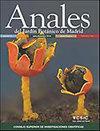An invasion risk map for non-native aquatic macrophytes of the Iberian Peninsula
IF 0.3
4区 生物学
Q4 PLANT SCIENCES
引用次数: 7
Abstract
Freshwater systems are particularly susceptible to non-native organisms, owing to their high sensitivity to the impacts that are caused by these organisms. Species distribution models, which are based on both environmental and socio-economic variables, facilitate the identification of the most vulnerable areas for the spread of non-native species. We used MaxEnt to predict the potential distribution of 20 non-native aquatic macrophytes in the Iberian Peninsula. Some selected variables, such as the temperature seasonality and the precipitation in the driest quarter, highlight the importance of the climate on their distribution. Notably, the human influence in the territory appears as a key variable in the distribution of studied species. The model discriminated between favorable and unfavorable areas with high accuracy. We used the model to build an invasion risk map of aquatic macrophytes for the Iberian Peninsula that included results from 20 individual models. It showed that the most vulnerable areas are located near to the sea, the major rivers basins, and the high population density areas. These facts suggest the importance of the human impact on the colonization and distribution of non-native aquatic macrophytes in the Iberian Peninsula, and more precisely agricultural development during the Green Revolution at the end of the 70’s. Our work also emphasizes the utility of species distribution models for the prevention and management of biological invasions.伊比利亚半岛非本地水生大型植物入侵风险图
淡水系统特别容易受到非本地生物的影响,因为它们对这些生物造成的影响高度敏感。基于环境和社会经济变量的物种分布模型有助于识别非本地物种传播的最脆弱地区。利用MaxEnt对伊比利亚半岛20种非本地水生大型植物的潜在分布进行了预测。一些选定的变量,如温度季节性和最干旱季度的降水,突出了气候对其分布的重要性。值得注意的是,人类对该地区的影响似乎是所研究物种分布的一个关键变量。该模型对有利区域和不利区域的判别精度较高。我们使用该模型建立了伊比利亚半岛水生大型植物入侵风险图,其中包括20个单独模型的结果。结果表明,沿海地区、主要江河流域和人口密度高的地区是最脆弱的地区。这些事实表明,人类对伊比利亚半岛非本地水生大型植物的定植和分布,更确切地说,是70年代末绿色革命期间农业发展的重要影响。我们的工作还强调了物种分布模型对生物入侵预防和管理的效用。
本文章由计算机程序翻译,如有差异,请以英文原文为准。
求助全文
约1分钟内获得全文
求助全文
来源期刊

Anales Del Jardin Botanico De Madrid
PLANT SCIENCES-
CiteScore
1.20
自引率
0.00%
发文量
9
审稿时长
>12 weeks
期刊介绍:
Anales del Jardín Botánico de Madrid features original and unpublished articles in fields such as taxonomy and systematics of all plant groups and fungi, including related fields like biogeography, bioinformatics, conservation, ecophysiology, phylogeny, phylogeography, functional morphology, nomenclature and plant-animal relations, as well as reviews and summary works. Anales del Jardín Botánico de Madrid is published half-yearly, with two issues appearing in June and December.
 求助内容:
求助内容: 应助结果提醒方式:
应助结果提醒方式:


